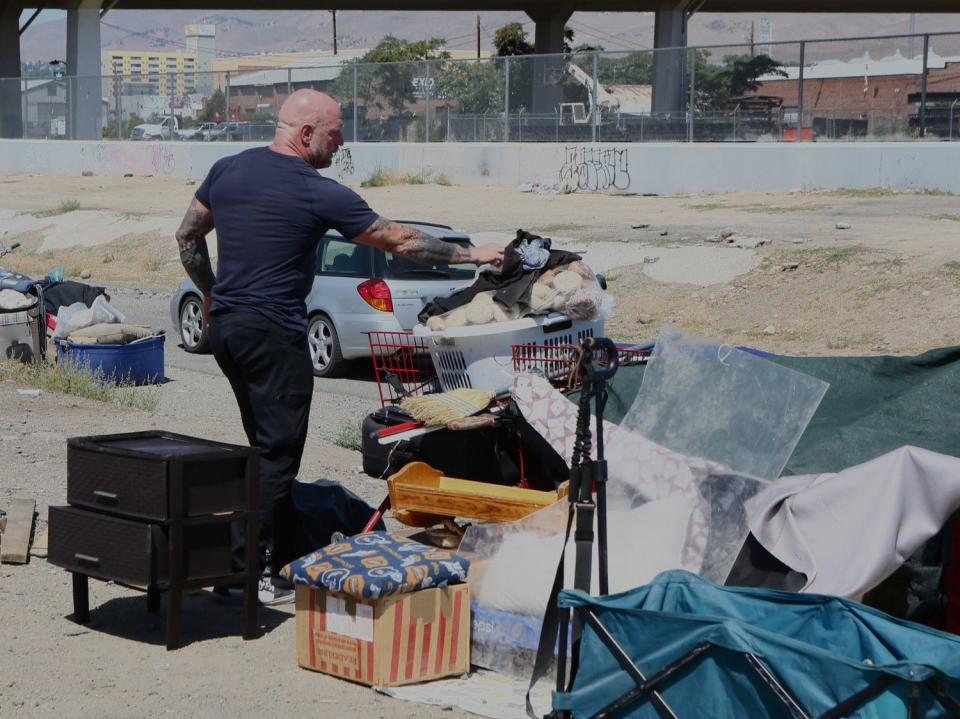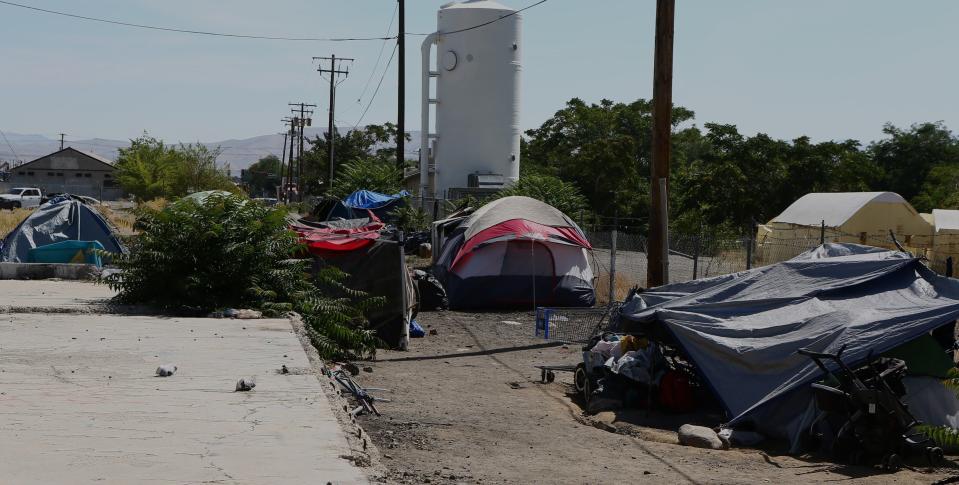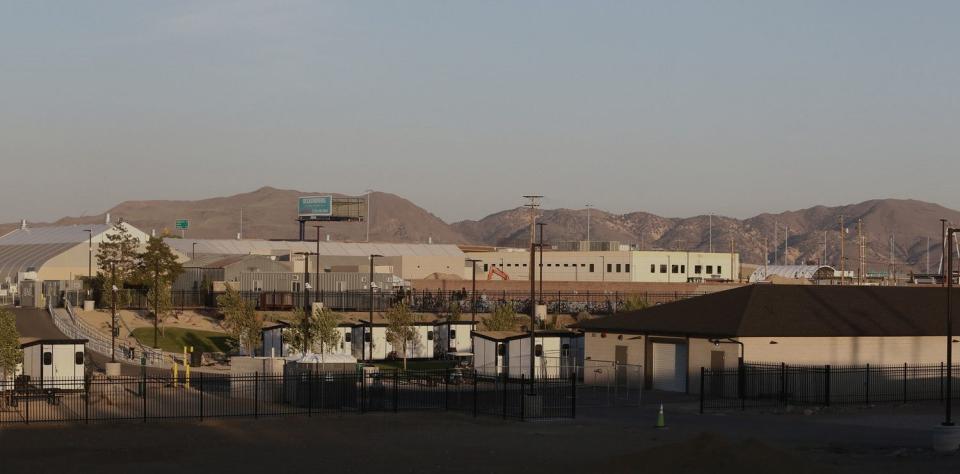Will Salt Lake City's sanctioned homeless campground model Reno's success?

For the first time in Utah, a sanctioned homeless campground will soon be set up in Salt Lake City.
In the past, such an idea was met with resistance from elected officials and the public. Still, even as the state has pumped hundreds of millions of dollars into addressing homelessness, the crisis has persisted.
"In my 10 years in public service, I've visited quite a few places to study how they achieved deeply affordable housing and different types of shelter addressing homelessness," Salt Lake City Mayor Erin Mendenhall said during a recent announcement about the sanctioned campground. "We've looked closely in these places and others, at what has worked and what has not worked well."
Among the places visited by Utah officials and the once reluctant Salt Lake mayor — who once compared the concept to a "genie" that can't be "put back in the bottle" — is Nevada Cares Campus Safe Camp.
The model was considered a favorite of Andrew Johnson, Salt Lake City's director of homeless policy and outreach, in April shortly after officials visited it. KSL.com visited the Reno camp last month to see how it works and what might be replicated in Utah.
Reno's Safe Camp
Just a little past the Truckee River, beyond an overpass and a few yards from the railroad tracks is a slab of concrete. The concrete home to a small homeless encampment.
The makeshift camp, with a handful of tents, resembles a fraction of those seen around Salt Lake City.
As a small van approached just along the train tracks on a recent August afternoon, volunteers emerged with meals and water. At the same time, Grant Denton's white truck appeared from the other side of the concrete slab.
Once the meals had been distributed and the volunteers disappeared, Denton began pushing discarded food and bags into piles. Several plastic bags filled with donated rolls and bread had become bloated from sitting in an abandoned shopping cart in the sun.
"One of the biggest issues is we're conditioning people to stay put. They never have to leave here. All their needs are met — people are bringing water, clothes and stuff," said Denton. "What are the unintended consequences? What happens when we over-give? You have a kind gesture, you have solving a problem, then you have pathological altruism."
Denton told KSL.com he had visited Salt Lake City just a few weeks prior to discuss the success of Reno's Safe Camp and pulled out his cellphone to show a selfie taken with Mendenhall.
The discussion was broken with a few runoff conversations between Denton and several unsheltered individuals who shouted out at him from across the camp. Denton playfully put up his fists as one man asked for a sparring partner.
Denton's demeanor is tough. He's tall with a square jaw and could easily be mistaken for a boxer. His face is weathered from the sun and years of experiencing homelessness.
"I eat, sleep and bleed this. I spent nine years, myself, in Vegas, addicted to heroin and meth in and out of the system, so I'm pretty passionate," he said.

Denton's lived experience is what inspired him to create Karma Box, a nonprofit centered on homelessness and outreach. Karma Box is contracted through Washoe County to run the day-to-day operations of the Safe Camp.
With a short salute by Denton when he arrived, the security gates of the Safe Camp swung open and he drove his white pickup inside. The camp is double lined with fences, with a security post at the front to check in residents along with metal detectors. Overhead lights line the perimeter of what once was a baseball field.
Beyond the walkup are small rows of pods — 45 in total. The "ModPods" are individual units that are insulated and provide heating and cooling in addition to electrical outlets for personal devices. Each unit contains a bed, enough space for someone's personal belongings and a door that locks. The model is meant to target those who are shelter-resistant — meaning those who can't or won't stay in homeless resource centers for a variety of reasons.
Much like Salt Lake City, the housing affordability crisis has hit Reno hard. The growing population and the dwindling availability of affordable housing has pushed many low-income residents to homelessness. Some found themselves along the banks of the Truckee River. Tents, tarps and makeshift shelters began to group together and grow along the shoreline before spilling into the parks and other public spaces. The embankment resembled what appears along the Jordan River in Salt Lake County now.
In response to the crisis, the Clean and Safe program was launched by officials in January 2020 in an effort to clean the encampments and connect unsheltered people with services.
"When they first built the Cares Campus, and everybody's living on the river, our outreach team was out there trying to get folks into the Cares Campus and some people were like scooting around going (there), so we created the Safe Camp," Denton said.
The Safe Camp was piloted in June 2021, beginning with the program providing participants with a tent, sleeping bag and a cot in a specific location within camp temporarily located on East 4th Street.
"We were thinking that the whole mission would be people come to us because you got illegal camping, legal camping, shelter, and then tier up transitional housing and tier up as you go. But it turns out, it just makes more sense that when somebody comes in here, just to go straight to housing, instead of sending them to another emergency shelter," Denton added.
Reno's expansion of emergency shelters with the Safe Camp has made a significant difference. The sprawling camp of upwards of 500 unsheltered individuals along the Truckee River has dwindled, with most finding shelter in the Safe Camp or emergency shelter or being housed.
Washoe County officials' data revealed there are 1,690 people experiencing homelessness, which is an increase compared to last year's count of 1,605. While homelessness rose slightly, there was a 21% decrease in people living unsheltered — such as in a tent or car or on the street — between 2022 and 2023. Of those experiencing homelessness were 1,361 people living in emergency shelters or transitional housing programs — a 14.5 percent increase from 1,188 in 2022.
Despite homelessness increasing slightly, fewer people are living unsheltered and are accessing services and housing quicker in Reno.
Lessons learned
Denton called the tents "a terrible idea." The Safe Camp quickly ditched the tents in the fall of 2021. With Reno's climate, which is similar to Salt Lake City's, occupants found themselves either freezing in the tents or baking in hot temperatures.
"The reason that tents aren't good is because you need your staff to be hyper-focused on getting people housed, and what does that look like? You don't want your staff focusing on replacing tents," Denton said. "Tents have a really small half-life. You can't have heating in there because they'll burn down."

The tents were replaced with the ModPods seen on the campus today and likely what will be seen in Salt Lake City, as well.
"Better than tents, we are going to use pods," Mendenhall said in a recent forum on housing and homelessness. "People in the state of Utah deserve better than tents and we deserve better than to solve the state's homelessness crisis all by ourselves."
Salt Lake City's sanctioned campground will be located at 558 W. 300 South and is anticipated to open in November and close by April as a pilot project. It will serve around 50 people, utilizing $500,000 set aside by the Salt Lake City Council and state investments to do so.
The pilot will feature pods of 50, with heating and cooling. The sanctioned campground will also feature bathrooms and showers, a kitchen and services, Mendenhall confirmed. The model resembles much of what's been built at the Safe Camp in Reno. The pods are transportable and affordable, she added.
The permanent location for Salt Lake City's sanctioned campground has not yet been revealed by officials.
"This is something we've envisioned for quite some time, and we've been planning on it probably for over a year," Utah Homeless Coordinator Wayne Niederhauser said about the project. "It's an exciting time to find a place for us to implement this plan."
The Reno campus allows pets and partners, who are housed in a separate pod. Bathrooms, pavilions and a dog run are also available on the property. A community center is currently under construction that will provide computers, a kitchen to prepare food and showers. Residents aren't allowed to have personal belongings overflowing in the space, block the emergency exit or puncture the walls.
"We do pod checks often so that the pods don't get out of control. That can also cause behavioral issues," Denton said. "What's out of control? Rotting food, things being piled up, hoarding, insects, rodents, all the things go on and on. The thing is ... you want your system to model the system you want them to succeed in. So, we're just gradually doing these little cultural adjustments that take a little bit of time."
Another lesson? Location is everything.
The Safe Camp pilot moved from a temporary site on Fourth Street to the Governor's Bowl just off I-80, where security was increased with fencing and a metal detector. So far, the camp has only experienced two overdoses. The Safe Camp is considered "low-barrier," meaning that sobriety is not required for entry, but pod checks are frequently conducted to check on residents’ well-being.
"It's a game changer. The location's everything," Denton said. "When you create a barrier, you have less behavioral incidences. When we moved down here the behavioral incidences dropped to just about none."
Cost breakdown
What's to come for the sanctioned campground in Salt Lake City has been painted in a broad stroke by officials, but the finer details such as plans for long-term funding have yet to emerge.
The cost of the ModPods are about $10,000 to $15,000. On average, a person experiencing chronic homelessness costs taxpayers about $44,000 per year, or about $120 per day, according to data from the National Alliance to End Homelessness.
The Safe Camp's fiscal budget in Reno is $1.4 million. The addition of Washoe County's more traditional homeless shelter on a nearby property, which houses approximately 600 people, brings costs to about $17.4 million to operate annually.
The numbers balance out with a decrease in calls to emergency services and an increase in supportive housing, said Dana Searcy in a recent Washoe County Board of Commissioners meeting.
The average cost of a shelter bed is approximately $74 a day while the cost of detention is $161, transportation by emergency services at $550 per trip and treatment at the hospital at $2,397 a day, according to Washoe County data.
Despite the affordability of the pods, funding still seems to be of concern for officials in both Washoe County and Salt Lake City alike.

The Safe Camp and traditional shelter were built with COVID-19 relief funds and have continued to operate on those funds. As the funding nears its end, an ongoing funding source is needed to continue operations.
"The first issue is that these are one-time funds — COVID funds. So they're good to build facilities, but they're not sustainable to operate. And that was my concern with what was happening in Reno, and their concern," Niederhauser said. "They're concerned, but they felt like this was such an important thing that they'd get out over their skis a little bit and then maybe force more of a conversation."
The Utah Legislature's 2023 appropriations bill included $30 million in American Rescue Plan funds being allocated to homeless services in fiscal year 2024, according to data published by lawmakers' fiscal analyst office. The federal funding allocation is less than the previous year but more than the state's contribution.
Funding set aside for the Office of Homeless Services fell from $22.1 million to $12.1 million between the 2022 and 2023 session.
"We could have been more aggressive with putting a lot more infrastructure on the ground with COVID funds here in Utah, city, county and state, but you have to have the operating funds," Niederhauser said.
"It's going to be much more difficult to secure those funds through the Legislature not only here in Utah, but anybody across the country, in every county in every city. That money that helps with that infrastructure now it's not there, and how are we going to continue to find that because this is an ongoing problem," he said.

